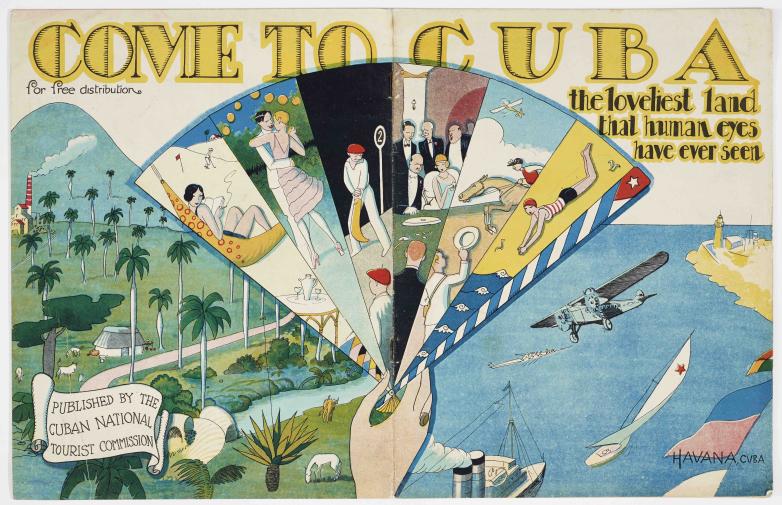Works by Cuban Graphic Artist Conrado W. Massaguer on Exhibit at The Wolfsonian–FIU

Pamphlet, Come to Cuba, c. 1930. Conrado W. Massaguer (Cuban, 1889–1965), illustrator Cuban National Tourist Commission, Havana, publisher Sindicato de Artes Gráficos de la Habana, S.A., printer.
Miami Beach, FL — In a focused installation, The Wolfsonian–Florida International University highlights the transnational legacy of Cuban graphic designer, illustrator, publisher, and caricaturist Conrado Walter Massaguer—a leading voice in shaping early 20th-century Cuban culture who is often credited for bringing modernism to the island nation. Cuban Caricature and Culture: The Art of Massaguer, on view June 7, 2019 through February 2, 2020, presents selections from a new gift of Massaguer material from collector Vicki Gold Levi in addition to loans and other Wolfsonian collection objects. Featuring magazine covers, advertisements, original paintings, rare sketches and personal letters, and caricatures of famous figures from Hollywood stars to royalty and presidents, the nearly 100 works on view call attention to Massaguer’s profound influence on design in both Cuba and the U.S. over his 40-year career.
“Conrado Massaguer’s art left an indelible mark on Cuba, helping to define not only what Cubans considered ‘in vogue,’ but also informing day-to-day culture and politics,” said Frank Luca, Wolfsonian chief librarian and the installation’s curator. “Though he won his international acclaim a century ago, his style remains fresh and imaginative in a way that still feels incredibly modern to us today.”
Added Gold Levi, “I first discovered Massaguer through his magazine Social when I began research for Cuba Style, a book I wrote with Steve Heller—I was immediately captivated! As I continued studying, collecting, and traveling to Cuba over the years, I only fell deeper in love with Massaguer’s witty graphics and simple, pure, evocative lines. I’m honored to collaborate with The Wolfsonian on raising awareness about such a versatile, talented artist.”
Born in the Cuban city of Cárdenas, Massaguer (1889–1965) was educated in both Cuba and America and frequently traveled back and forth, simultaneously building his reputation as a premier artist and art director in Havana and New York City. Over the course of four decades—and particularly during a brief exile in the U.S. during Gerardo Machado’s dictatorship—Massaguer became a prominent trendsetter in America by designing covers and illustrations for many of the leading magazines of the time, including Vanity Fair, Collier’s, Cosmopolitan, and Literary Digest. While he took many cues from American publications and artists for these commissions, Massaguer put a distinctly Cuban stamp on a 1931 exhibition of his work at Delphic Studios, a New York gallery. There, Massaguer’s impressions of his native country were placed front and center, with a uniquely Cuban flavor evident in the style and themes.
Back in his homeland, Massaguer likewise cemented his role in publishing by founding and art directing his own lifestyle magazine, Social, in which he nurtured the careers of numerous Cuban illustrators and caricaturists. From the 1920s into the 1950s, Social set the tone for Cuban values and taste, heavily publicizing the idea of the liberated and sexualized “new woman” (or flapper) and incorporating a bold Art Deco aesthetic. Massaguer was also central to Cuba’s tourism campaigns, creating striking advertising art that packaged Cuba as a product and sought to lure Americans south through vibrant visions of a tropical playground. His status in Cuban society brought him in close proximity to foreign dignitaries, politicians, and visiting celebrities, many of whom he parodied in his signature, New Yorker-esque caricatures.
Key works in Cuban Caricature and Culture are:
• A humorous self-caricature used by Massaguer to announce his arrival in New York in the 1920s and introduce himself to the American art scene;
• A sketch of Walt Disney paired with a photograph of Massaguer and Disney;
• Several illustrations of the artist’s “Massa-girl” types, fashionable women with bobbed hairstyles that popularized the “new woman” ideal in Cuba;
• Come to Cuba, a vibrant, early-1950s brochure produced for the Cuban Tourism Commission that touts the various attractions (dancing, beach-going, gambling, and horse racing) of “the loveliest land that human eyes have ever seen”;
• A Social cover showing a Deco-style evolution of the “new woman”; and
• A Christmas holiday advertisement for Esso made in the aftermath of the Allies’ victory in the Second World War, with caricatures of Joseph Stalin, Winston Churchill, Franklin D. Roosevelt, Charles de Gaulle, Chiang Kai-shek, and Santa Claus.
Massaguer’s immense popularity is reflected in a robust market for fakes that Cuban Caricature and Culture will address through a counterfeit illustration of Albert Einstein. By displaying this fraudulent piece beside a genuine version, The Wolfsonian reveals the forger’s tactics for, and missteps in, mimicking the designer’s trademark flair.
The installation coincides with the publication of Promising Paradise: Cuban Allure, American Seduction, a new companion book to a 2016 Wolfsonian exhibition of the same name also drawn from Vicki Gold Levi’s gifts. Touching upon many of Massaguer’s groundbreaking works, the book is the culmination of twenty years of Gold Levi’s interest in Cuban memorabilia and photography, and a capstone to almost two decades of Wolfsonian support and ongoing gifts.
“The Wolfsonian’s collection is renowned for its examples of graphic design, yet until Vicki’s gifts just a fraction demonstrated the mammoth impact of Cuban culture on its northern neighbor,” said Wolfsonian director Tim Rodgers. “This new material marks an exciting addition that proves how our cultural exchange was indeed a two-way street paved in large part by Cuban artists and tastemakers. Sharing Massaguer’s story right here in Miami—the gateway to Latin America—is remarkably fitting.”















